Mosques, Mausoleums, and the Masses: the Silk Road Cities of Uzbekistan
- mkap23
- Nov 14, 2019
- 22 min read

We looked up at the ceiling in awe. The amazing tile work, intricately assembled together to look like one large mosaic. The brilliant blue and green artistry etched onto the stalactites, hanging down from the portico. The Arabic calligraphy, illegible to us, but communicating a story through its beauty alone. The minaret ornaments and camel magnets, glistening in the morning light like….wait, what?
“First mosque, now handicraft center,” said the woman selling her wares inside the old prayer room at the Abdul Aziz madrassa in Bukhara. “Good price for you.” The legendary Silk Road cities of Samarkand, Bukhara, and Khiva are still very much alive today, no longer active in the exchange of silk or slaves, but in the tourist trade. In this, we found both brilliance and bothers galore.
One of the main reasons we were drawn to visit Central Asia was the feeling that this was one of the few unexplored corners left on the globe. It is a region that is rarely studied in Western schools or discussed in the news (except for that brilliant John Oliver piece from a few months back; for the record, we are not going to Turkmenistan). Many people we know can’t even name the ‘Stans, let alone spell them.

Up until this point, this notion was confirmed—we had only come across a few intrepid backpackers or HEB’s along the way. But the three principal Silk Road cities in Uzbekistan were another story—we had found the tourist trail. Compounding this is the fact that the cities are old and compact, so it feels disproportionately inundated with tourists. And of course, with foreign dollars comes the chance for locals to make a buck, as displayed by the shops located in the old mosques and madrassas, or the dressed-up camel conveniently waiting for a photo op. It didn’t help that we had come from Kyrgyzstan, where there is nearly none of these sales, tourist traps, or tour groups, so our point of reference was skewed and unprepared.
The crowds and commercialization themselves did not really hinder or detract from our experience. For one, these cities have attracted travelers from around the world for centuries, so we can’t really complain about it now; and in some ways, the commercialization today was likely no different from the merchants of old, peddling their wares in the covered bazaars (albeit different wares). Secondly, the tour groups came through the sites quickly, so if you are just patient for a few minutes, you can still find some time alone.
What was more bothersome, though, was the sanitized tourist experience that these cities felt we needed. Look, we certainly understand that the government wants to put its best foot forward to foster a growing tourist industry and to create a safe and hassle-free environment that Westerners desire. And it’s mostly working, because we have had an amazing experience in Uzbekistan and felt very safe the whole time. So, while things like the Clorox-cleansed main street of Samarkand and the turnstiles to enter the old city of Khiva were frustrating, they were also predictable. It was the consequences beyond these superficial changes that were upsetting—the old city of Samarkand is literally walled-off and hidden from view, and large-scale demolition outside the fortress walls of Khiva have created a half-constructed, dusty wasteland where most of the locals live. It is unfortunate that the promotion of these historic cities has to be at the expense of the full story of what Uzbekistan is all about, good or bad.

Nevertheless, these complaints are minimal compared to the positive things we have to say about the experience of traveling through these fascinating lands of bygone empires; of shahs, khans, and emirs; of civilizations that stretch back to the 5th century BC. It was awesome to see what one could build with outlandish wealth back then, to view ancient Islamic architecture that is both incredibly grand and intricately detailed at the same time. It was inspiring to see the focus on education date so far back into history; sure, it was a study of religion, but also of math, science, and astronomy. And, it was fun to visualize what life might have been like as a Silk Road merchant or caravan trader, as these cities—Bukhara and Khiva in particular—are extremely well preserved.
Finally, through the swarm of tour groups and congo lines, we were able to meet and befriend some of the most interesting and fascinating tourists yet: the seasoned backpacking Brits, the history professor on East Asian Muslims, and the best-selling novelist, all of whom made us appreciate how Uzbekistan still continues to attract a unique type of traveler from all over the world.
This blog is going to cover Samarkand, Bukhara, and Khiva in one go, so we apologize that it is a bit long. We don’t mind if you end up just scrolling through the photos. We also recognize that it is likely unfair to lump them all together as one contiguous place, when in fact, there are ethnic, cultural, and language differences between these regions. They are also historic rivals, warring over lands and trade (Khiva built their massive minaret two meters taller than Bukhara’s just to top them, so even back then, there were building height rivalries). However, the tourist experience is to visit them all together, sequentially, which inevitably leads to lumping and comparison. And despite our complaints about tourists, we are tourists as well, so we will do the same. (We are also heading to Myanmar soon, so we need to wrap up Central Asia and not spend our entire life blogging. Editor’s note: at time of posting, we have now been in Myanmar for weeks already.)
Samarkand

We walked out of our guest house and turned left, heading down the narrow cobblestone street in the old Jewish Quarter. Tall brick walls concealed the homes of the now mostly-non-Jewish residents of Samarkand, the only hint of individuality being the beautifully carved wooden gates that lead into the shared courtyards of the extended families that live behind them. Despite these privacy screens, life still thrives on the street, as kids play in alleys and the Tajik-speaking residents gossip about who-knows-what. We continued a few hundred feet, passing a small mini mart on one corner and arriving at a large gray steel wall. On the right side of the wall was a small, semi-hidden doorway with the door ajar. We stepped through the doorway.
We are not trying to be dramatic, but stepping through that doorway seriously felt like we stepped through a portal into another world—and one we did not expect. What was once the old city of narrow back alleys and open storm drains just one meter away behind the wall, gave way to a polished brick path with stately trees and manicured green lawns. We came upon a nearly-perfect straight road (Tashkent Street, which was recently renamed to Karimov Street in honor of their former supreme leader), lined with glass storefronts displaying trinkets, wood carvings, and ikat prints that all looked the same. Hordes of white people walked by happily. We could have been in the Truman Show. It was very bizarre. The only hint that we were still in Uzbekistan was, ironically, a Disney-like tram that whizzed by, carrying locals.
And then we turned to the right, and caught a glimpse of Bibi Mosque.

Bibi Mosque is awesome. A tall minaret with large Arabic writing that somehow looks both tribal and digital at the same time, greeted us at the corner, signaling its location as a significant site of prayer. Three large blue domes dot the skyline, standing in defiance of 15th century structural engineering practices (though the domes and mosque have since been heavily restored by the Soviets). A massive entryway with large wooden carved doors frame the entrance.
For a few seconds there on Tashkent Street, we had felt like we were in the wrong place, accidentally ending up in a bad version of Disney World. But now, seeing Bibi Mosque from that same spot on Tashkent Street, we suddenly felt the power that draws visitors to Samarkand.
One of the biggest religious structures we have ever seen, it is estimated that 10,000 people could have worshipped there when it opened in the early 1400s. Most of the mosques and madrassas we visited are laid out in a similar fashion to Bibi, with a front entry portico that leads into a central courtyard and prayer rooms or study rooms lining the other three sides. But everything at Bibi is magnified. The main dome is massive, as is its courtyard featuring several large shade trees. Walking along the walls and through the courtyard was both relaxing and inspiring. Additionally, because Bibi is undergoing a restoration (one of many through the centuries), we were able to see the comparison between the newly-restored sections and the older, unrestored areas, which is always educational and fascinating.
About the only thing older than the mosque itself, were the visitors.
Uzbekistan must be doing some great targeted advertising in the European senior citizen sector (proposed tag line: If you can stand, come to Uzbekistan!), because this place is filled with gray-haired Brits, Germans, Dutch, Spanish, Italians, and other European places whose languages we couldn’t identify. At one point, we even overheard a woman on the train saying that she needs to sit next to her friend because, “She’s 84, and I’m 75, so I need to care for her!”
Now, we certainly have no issues with seniors traveling. In fact, it was very inspiring and gives us hope for the future that getting old may not totally suck. It even prompted a discussion of what might be the “Uzbekistan of the future”—where will be the exotic place we can visit in a group tour when we turn 75? (Iraq? Kansas?)
But it was the way these seniors’ travel was organized that was annoying for the by-standing backpacker—their buses pulling up and unloading in large groups, flooding the entrances with waves of slow-walking people; their tour guides erratically waving flags above their head and shouting loudly to gather their group (though we were impressed with the amount of languages the local guides spoke). There were even restaurants that turned us away, because they would only serve the tour groups! The all-inclusiveness, without having to think about where to go or what to do, may be Club Med for them, but it felt more like Club Dead to us.
To an extent, we knew this was coming. When we were in Tashkent a couple days earlier, we met up with some local college kids whom we met through Couchsurfing. One of them is from Samarkand, and he was shocked when we told him we were heading there next: “You are too young to be going there, everyone is old there.” There is likely a sound reason to explain this octogenarian interest. It is our understanding that when Uzbekistan was closed off, it was hard to get a visa, so one could only go with an organized tour. These types of tours are expensive, and thus, naturally attracted more retirees and few backpackers for decades. It appears this pattern has stuck, even though it is now much easier to get a visa, and it is relatively inexpensive and easy to get around.
We feel bad for ripping on the old people, but they were part of our experience, so it had to be done. Sorry, old people. But judging from the exuberant way you drank your bottles of wine and guffawed loudly in every restaurant where we sat next to you, you don’t seem to mind. (By the way, for a city that revolves around tourism, there are practically no restaurants to speak of in Samarkand—it’s very strange.)
After seeing Bibi Mosque on our first day, we went out to see the gem of Samarkand the next day—the Registan. To get there, we begrudgingly had to go through our “portal” and walk down Tashkent Street. Geez, this street sucks.

Meaning “Sandy Place,” the Registan is a large complex made up of three buildings, the oldest of which was constructed before Columbus reached the New World. All three buildings are old madrassas, or schools, so the Registan is almost like a college campus of sorts. But instead of ivy growing up the mud brick walls, it is decorated with incredible tile work. As amazing as the sheer size of the buildings, domes, and (tilting) minarets are, it is the brilliant color and artistic details that make the Registan special.
Its designs of colorful geometric patterns, framed by Arabic calligraphy and topped with turquoise blue domes, are signature design elements of what came to be known as Timurid architecture, named after Amir Timur, who was the emperor who rebuilt Samarkand after it was destroyed by the Mongols in the 13th century. This aesthetic has been copied throughout much of the Islamic World, and even inspired the architecture of the Mughal empire in India (which was founded by a Fergana Valley native), including the Taj Mahal, which features numerous characteristic Timurid components. Timur’s grandson was Ulugbek, an astronomer who built the first madrassa at the Registan (appropriately called the Ulugbek Madrassa) in 1420 to teach the subject, along with math and philosophy. The stars on the portico are unique to madrassa design, and reflect his studies of the universe; the madrassa now houses an interesting exhibit on astronomy that displayed some cool Middle Eastern astrolabes (we love astrolabes)—along with many tourist shops.

The second (middle) madrassa is called the Tilla Kari Madrassa, which means “gold-covered madrassa.” This is a very apt name, as the interior of its mosque is almost completely decked out in brilliant gold. While this may sound gaudy, it represented such skill and inspired such admiration that it was actually one of our favorite spots in all of Central Asia. This madrassa also houses a small, worthwhile photo exhibit showing photos of what the Registan looked like before it was restored—it was in pretty bad shape! Of course, inside the old study rooms and dorms are more souvenir shops.
Finally, the third building at the Registan is the Sher Dor Madrassa, which means “lion madrassa.” It is the newest of the bunch, built “only” in the 1600s. Lions and other animals adorn the façade, designs that are Mongolian- and Zorostrian-influenced (so we’re told), rather than Islamic. Maybe they were trying to ward off the Mongols from coming back and destroying this beautiful creation, since the Mongols seem to have destroyed everything else we come across. (Interesting fact: the terms “khan” and “khanate,” used to refer to emperors and empires in this region, derive from Genghis Khan; this seems obvious now, but somehow we never made the connection.) Also inside this last madrassa were—you guessed it—souvenir shops.

The other, final architectural gems in Samarkand are its mausoleums. The Gur-e-Amir, which houses the tombs of Amir Timur and Ulugbek mentioned above, was almost as brilliant as the gold mosque in the Tilla Kari Madrassa. Even more impressive was the Shah-i-Zinda, a complex of 20 or so mausoleums aligned in a street-like fashion. The tile work here was truly mesmerizing—almost all the mausoleums are fully covered in intricate blue tile designs; many of them represent such fine artistry that you can barely see any spaces or “grout” in between them. At the end of the “street” is a cluster of particularly grand mausoleums that likely house some of Amir Timur’s family and other past shahs (they are not entirely sure). Most interesting of all, despite its narrow corridors being overrun with tourists, Shah-i-Zinda remains a sacred place where locals still come to pray and pay respects, which we were able to witness and observe.
After ample sightseeing and back on the other side of the wall, we met up with a British couple who were also staying in our guesthouse and hung out with them on and off for the next week or so. They had previously traveled around the world for 18 months, and thus gave us lots of helpful advice about our future destinations. It is always comforting—and affirming—to meet other folks who are doing or have done a similar trip as ours.

We also appreciated the Brits’ sarcastic humor, especially about the Registan light show. If there is anything that sums up the confluence of senior tour groups and historically significant Uzbek landmarks, it’s the Registan light show. The Registan may be brilliant by day, but it’s even better by night—because it basically turns into a discotheque. Every night, they put on a tacky, yet admittedly awesome, trippy laser light show on the façade of the three buildings, set to catchy music. They even play a cheesy promotional-sounding song called “Samarkand Samarkand” (creative name) that sounds like one of those songs they play at a luau (for those who know, just imagine the Uzbek version of “This Is Aloha”). It was so fantastically cheesy, that we had to go back to watch it a second night with our Brit friends.
Luckily, “Samarkand Samarkand” only stuck in our heads for a few days, but the beauty of Samarkand will linger for a little while longer.
Bukhara
The next day, we boarded camels to make the journey between Silk Road cities.
OK, not really, we actually took a high speed train between Samarkand and Bukhara (even freakin’ Uzbekistan has high speed rail—c’mon California!). In less than two hours, we were walking around the extremely well-preserved city of Bukhara. While Samarkand may have the grander sites, we actually enjoyed Bukhara more, as it seems more representative of overall life in an ancient Silk Road city (read: no Disney tram taking you between the key sites, and there are still some ruins lying around). This is not to say that Bukhara doesn’t have its own beautiful structures and architecture, as well; we visited magnificent mosques and madrassas aplenty—too many to name here—each also displaying unbelievable tile work and designs. The Kalon Minaret is so remarkable, in fact, that when Genghis Khan sacked Bukhara in 1220, he spared this 12th century minaret, making it the only structure in the city to survive, because he was that amazed by its beauty and gravity-defying height.

It’s just that there is also life beyond the sites, such that no single structure dominates the city. For this reason, Bukhara is a great city to stroll through without an agenda; you can lose an entire day just dipping through the old covered bazaars, lounging in the shade, hanging out with the mosque cats, or getting a drink while enjoying the views around the old Labi Hauz, an ancient pool at the city center that was part of a complicated water system for the oasis city. There are nice cafes, bars with views, and even a “fancy” restaurant for which you need an advance reservation—something we had not yet encountered in all of Central Asia! We dined here with our new Brit friends from Samarkand one night; the food was OK, the wine was pretty horrible.
We also had the chance to get outside the touristy areas of Bukhara a little bit and explore, especially through the old Jewish Quarter. Jews have lived in Bukhara for centuries, working as traders along the Silk Road. They even created their own language, a unique blend of a Persian/Tajik dialect, but one that uses the Hebrew alphabet. While most Bukhari Jews now live in Israel or Queens, a community of a couple hundred Jews still exists, and the Uzbek government actually wants more back: Israelis can visit Uzbekistan visa-free, with the hope that some of the old Bukhari Jews might return.

There are two working synagogues left (one had a “bima in the round,” which we had never seen), as well as a Jewish Day School. While walking by the school, we happened upon an Israeli tour group that had just arrived and was getting ready to see a performance by some of the students. So, we stuck around to watch some dancing and poetry recitation, though we couldn’t understand anything since it was all in Hebrew (not that being in Tajik would have helped). We also had a chance to go to the old Jewish Cemetery; unfortunately, we were not allowed to walk around inside, as it was closed for Sukkot, but it was still interesting to see how large the Jewish community once was by the size of the cemetery, which has over 10,000 grave sites. (Interestingly, we entered the cemetery gate with another family, and when the cemetery guard started to tell us that it was closed for the holiday, the mother almost broke into tears and said that her grandfather was buried there and that he had escaped to Uzbekistan from Poland in 1944; she had come all the way here to find his grave. They let her and her children in, but when they turned to us, we had no such story—so we just respected the policy and turned around.)
Another interesting fact is that many of the guesthouses in Bukhara today were the homes of old Jewish merchants, including the one we stayed in for the first two nights. It was here where we met a Canadian-American traveling with his young son. Michael immediately judged that we wouldn’t like him because of his Red Sox hat, but he turned out to be incredibly fascinating, and we ended up hanging out with them for a couple days. He is a college professor of East Asian studies, focusing on Muslims in East and Central Asia, so he was very knowledgeable about the region and we were able to learn a lot from him. He even spoke Mandarin, Uighur, and Uzbek!
We all decided to get away from the tourists a bit and go on an adventure into the Kyzyl Kum Desert outside Bukhara. The guidebooks don’t describe any areas in the Kyzyl Kum to explore, and a number of locals we spoke to said there isn’t anything out there, so we basically turned to Google Earth, picked a spot that looked like it might have a bit of water and interesting terrain, and told a driver to take us out there.
We can confirm that the locals were right—there is, in fact, nothing out there.
The road out was occasionally treacherous, if not for the road conditions, then because there were so many trucks and heavily packed cars along the route. When we asked the driver why that was the case, he said that these were truckers and families coming to and from Turkey and Russia! It turns out that many families would go to Moscow to visit, buy a ton of things they can’t get in Uzbekistan, and then drive it all the way back over 3,200 kilometers—a modern day Silk Road caravan!

Road conditions aside, the desert adventure was worthwhile if only because we stumbled upon an amazing herd of camels grazing near a watering hole. We got out of the car and hung with them for a bit, and they just looked up at us in confusion; the only one more bewildered as to why these Americans were out in the middle of the desert was our driver. (By the way, the camel is a crazy and amazing creature. Forget Area 51—if you want to go looking for alien life, start with the camel!)
We also discovered that there is more desert life than meets the eye. We ended up hiking through some beautiful desert plants, whose new growth was a vibrant shade of red. There was also abundant cattails in the marsh oasis, whose densely-packed seed pods made for fun seed bomb explosions (which the 8-year-old discovered and taught us). And, there is apparently enough plant life for animals to graze out there, as we saw not only camels, but also some cows, sheep, and goats, and a wild fox!
During this desert walk, we connected more with the professor about our shared experiences traveling through Xinjiang, China (where the two of us visited in 2013 and where he had lived and worked for several years over the past decade), learning more about the current sad Uighur situation in China and how it has significantly worsened even since we were there. The professor also shared with us his incredible story of being detained by Chinese police while traveling there, due to his profile and knowledge. We were impressed by how easily he was able to laugh off what was likely a scary situation, but the way he described how the authorities used an obvious good cop/bad cop routine and had a black car slowly following him wherever he went—straight out of some bad detective movie—it did almost sound comical. The professor cannot go back to China anymore, but he continues his fascinating and important research work and publications (while raising one hell of a son—the most loquacious and mature 8-year-old we’ve ever met, who fully exercises the vocabulary of a professor and kept up with us no problem during complex geo-political discussions!).

After we had experienced the desert life of the Silk Road, we decided that we wanted to experience the city life as a Silk Road traveler. Through Couchsurfing, we met Jamik, who helps run a few small businesses out of an 18th century caravanserai in the middle of Bukhara’s Old City, while maintaining a few spare rooms to host travelers. A caravanserai, as you remember because you are an avid reader of our blog, is essentially a hotel or rest stop for Silk Road travelers. The two-story brick structure featured cell-like rooms, where we slept on floor mats on the dirt ground and occasionally felt like we were lying inside a giant brick pizza oven; while it had no windows, it was honestly quite cozy (but let’s not discuss the bathroom). Jamik ultimately wants to fix it up and open an official hostel in the caravanserai, which actually sounds like a great idea because it has an expansive courtyard that would serve as the ideal common area for a hostel. Michael bonded with him over his efforts, because each day, Jamik would go down to the government office to try to navigate the bureaucracy to get a permit to get started!
Also in the caravanserai were a number of artists who rented rooms for their studios, whom we got to know fairly well—or at least as well as you can when you can’t communicate using words. The main gate to the caravanserai closed to the public at about 9pm each night, so we Couchsurfers and these artists were the only ones locked in there at night (if they worked late, which they all seemed to do). There was the metalworker who made the etched copper plates, who worked so hard that he basically slept in his studio at night. There was the artist painting postcards and landscapes by hand, the woman with her silk ikat prints and embroidered pillowcases, and a very impressive photo gallery displaying everyday Uzbek life.

But our favorite business in the caravanserai was not a business at all—it was the local chess club. Also started by Jamik, it was basically just a place for local men to come and drink tea and play chess, known as Shak Mat in Uzbek (essentially “check mate”). These guys would come first thing in the morning and stay late; in between games, they may run errands, do some work, or take care of other obligations, but they always seemed to come back and everyone knew each other. We ended up playing some rounds of shak mat with the locals, who proceeded to shak mat us every time. While we couldn’t communicate verbally with these players either, we could generally understand what they were saying through the context of the game, and it seemed like they were doing some heavy trash talking and joking around (all of which was warranted, given our skill levels compared to theirs). The only benefit of constantly losing was that they felt bad for us, so when it was time for us to leave, one of the chess club guys drove us to the train station. Next stop: Khiva.
Khiva
The last stop on our Silk Road journey was to the old Khorezm Khanate capital of Khiva in western Uzbekistan. Dating as far back as the 6th century (though flourishing as the capital in the 17th century), Khiva has a long history of being demolished. “At least ten times,” said our tour guide for the day, the last time in 1920. But that also meant that they had a lot of experience rebuilding and restoring, which was evident in Khiva’s almost picture-perfect representation of what it used to look like. If there is one complaint about Khiva, it is that it is too well-preserved, which almost sounds ridiculous, but it is so good that it is unbelievable; it often felt more like a movie set than a real city.

Having said that, Khiva is quite beautiful and certainly transported us back in time. It was a fun city to walk around, because it is very compact and, like all before it, features some stunning sites as well. Highlights include the Ark, the fortress where the Khan and his 40 concubines lived, which was interesting because despite the fact that there was a whole palace for the Khan, he preferred to conduct business in a yurt placed inside the palace, to honor their early nomadic ways. Across the way from the Ark is the stubby Kalta Minor minaret, never to reach its full height (the khan who commissioned it died before it was complete, and the next khan did not want to complete it lest the prior khan get the credit and glory for it), but still spectacular and unique in its artistry and complete coverage in green and blue tiles. And finally, there is the humble but beautiful Juma Mosque, built in the 10th century and so old that it has no large domes or porticos—just a roof, some very old wooden columns with carvings, and an area to pray. Securing these treasures, as well as a number of other minarets and mausoleums, is a fully intact, 30-foot tall wall, completely surrounding the Ichan Kala (Old City).

But the walls couldn’t prevent the latest version of the city’s destruction, taking place just outside Ichan Kala. Right outside the eastern gate (Polvon Daroza) was an area of about five to six square blocks that was completely leveled. We would not have known what was originally there, save for a half-block-long stretch of abandoned stores and homes that had yet to be demolished. From the top of the 180-foot Islam Khoja minaret—whose winding narrow stairway we climbed—we could see that they are building a road straight from the eastern gate to the newly constructed train station, which only opened last December 2018—providing a straight shot from train to tourist site. On some level, the appeal is understandable; tourists will be able to disembark from the station, walk down the shiny main street to their new hotel, and then stop by a restaurant or bar on their way into the old city. But we couldn’t help but think that this would become similar to Samarkand’s Tashkent Street: efficient, but devoid of any real people or actual Uzbek culture. Also, one can’t help but wonder whether the amazing hospitality and friendliness to tourists that have been the hallmark of our Uzbek travel experience may sour if so many families and businesses continue to be displaced due to the industry’s growth.
We mentioned that for one of the days in Khiva we had a tour guide, something that we had not done previously in the Silk Road cities. This came about through a Canadian traveler at our guest house. She had hired a guide for the day, and after chatting with her over breakfast, we decided to join her on the tour. As we hung out with her, we learned that she is a novelist. Now, we know people say these things all the time—“I’m a writer” or “I’m a photographer” or “I’m an artist”—and unfortunately, many of those are aspirational careers wherein the people are not actually doing those things to make a living. But it turns out this woman is indeed published, and her first book was a bestseller, reaching #2 on the Canadian charts! We’re not sure if #2 on the Canadian bestseller list is like winning second prize in the Monopoly beauty contest (collect $10!), but it still sounded impressive to us and we added her book to the long list of Kindle reads. More so, it was great fun getting to know her over a couple days in Khiva, sharing meals and stories while chasing sunset and climbing minarets together. Even funnier, her next destination was to Dushanbe to visit one of her fellow MFA grads, also a novelist, who, in his spare time, is an ambassador to Tajikistan! Maybe if he was the ambassador to Ukraine, he’d have some good material for his next book. (Zing!)

After two days exploring Khiva and saying goodbye to our new novelist friend, we decided to do another excursion out into the countryside. Unlike in Bukhara, this time we had an actual destination: Elliq Kala, or 50 Fortresses. Elliq Kala includes tons of ruins from ancient peoples who lived in the Khorezm region, dating as far back as the 5th century BC. Archeologists know little about these civilizations, and they actually don’t even know how many fortresses there really are, so they went with fifty. Though these civilizations date back much older than Khiva, it was still intriguing to compare these unrestored fortresses with the perfectly preserved Ichan Kala back in Khiva. Over the course of half a day, we visited three key fortresses—because fifty is too many. While we didn’t learn about each site as much as we’d like (there is no signage, and few online resources), the physical ruins of the forts were spectacular and completely worth the side excursion. Toprak Kala, thought to be some sort of palace, was the most well preserved of the bunch. Though thousands of years old, depopulated for almost as many, and completely exposed to the elements (and humans), one can still see where the rooms were located and even some details of what might have been a prayer room. Kizil Kala was the smallest of the bunch, but featured formidable walls that allowed it to survive for centuries. But the most impressive one was Ayaz Kala. Ayaz Kala is actually two fortresses, one built up on a hilltop, and another just below it. While there isn’t much left of the castles except the walls, its stunning location and view of the surrounding desert made it a great place to frolic and hang out for awhile…until the tour bus pulled up, then we left.

Back in Ichan Kala, we walked along some of the less explored fortress walls. It was late in the day and the temperature was dropping (the desert nights got cold!); we could literally feel the heat emitting from the mud bricks of the wall as the day escaped from it. Enjoying our last sunset in Khiva, we watched as the sunrays danced across the unique compact skyline of mosques, minarets, and domes, changing the green and blue tiles to deep orange and purples.
We knew the patterns by now: as soon as the sun set, we’d have to run to our desired restaurant before the tour groups got there just to get a dinner seat. Soon after that, the light show at Samarkand’s Registan would be starting, and the gate to the Bukhara caravanserai would be closing.
And, after over two weeks traveling Uzbekistan’s Silk Road, we would be bidding farewell to its worn paths and tour buses, incredible sights and quiet nights, and friendly smiles and open arms. The next day, we’d hop on a 17-hour overnight train ride from Khiva all the way back to Tashkent; we may as well have hopped on the back of a camel.
Karen and Michael
Samarkand, Bukhara, and Khiva, Uzbekistan, October 12-23, 2019




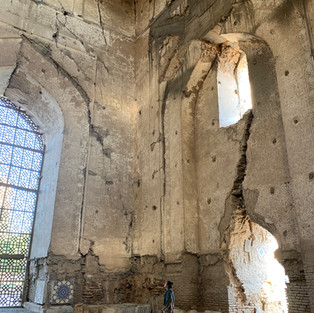










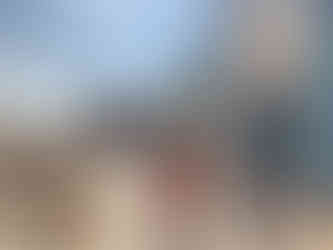

















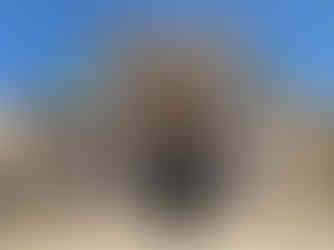































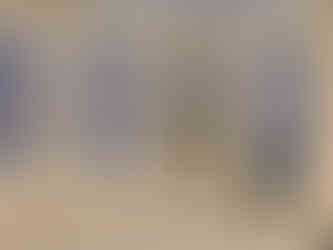




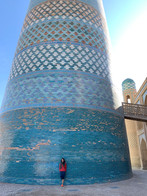








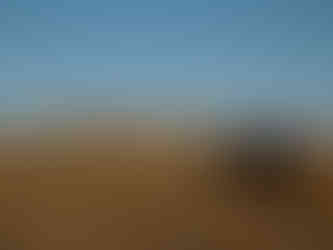












Comments